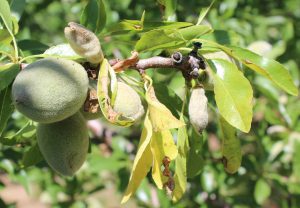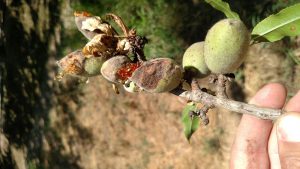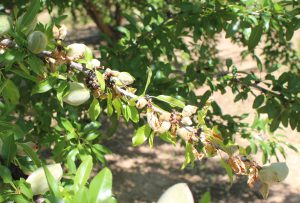Did you notice yellow, flagging almond branches this spring?

Flagging leaves and developing anthracnose lesions on Price almonds. Photo: J. Connell.
The anthracnose fungus, Colletotrichum acutatum, overwinters in infected mummies left on the tree and in dead twigs or branches resulting from infections the previous year. This year’s infections start when spores are splash dispersed by rain to the bloom or to new nuts. If small nuts are infected, they shrivel and turn a rusty orange color. Later in the season, if hulls are infected when nuts are full size, hulls gum and begin to shrivel. The initial circular hull lesions turn pinkish-orange as spores develop.

Advanced anthracnose lesions on Winters. Photo: D. Lightle.
Toxins produced by the fungus move back into the branch at the point where a spur with infected nuts is attached. Leaves begin to yellow and develop necrosis from that point out to the end of the branch. Defoliation follows, ultimately leading to limb die back to the point where infected nuts are attached.

Beginnings of dieback from anthracnose lesions on Price almonds. Photo: J. Connell.
Price, Peerless, NePlus Ultra, Fritz and Winters are highly susceptible varieties that usually become infected first. If the disease builds up, most other varieties including Carmel and Butte are susceptible, while Nonpareil is least likely to have a problem.
Ongoing rain triggered this disease in some orchards this spring. Infections can occur as long as rains continue thus requiring extended fungicide protection. Summer infections can occur if high-angle sprinkler irrigation contacts the tree canopy.
If you experienced this disease, both cultural practices and well-timed fungicide sprays will be important for control in the future. Dead wood should be pruned out and removed before the end of the season to eliminate this source of disease inoculum the following year. In our experiments, simply pruning out dead wood reduced the following year’s infections by 50% compared to trees where dead wood was not removed.
The costs of pruning out dead wood and the loss of future production as fruitwood dies greatly exceed the cost of preventing the problem in the first place. If you expect your fungicide dollars to work for you, spray materials must be applied in a timely fashion and with good solid spray coverage. Preventing this disease is money well spent.
See the UC IPM website for more information on effective fungicides registered to control this disease.


Leave a Reply